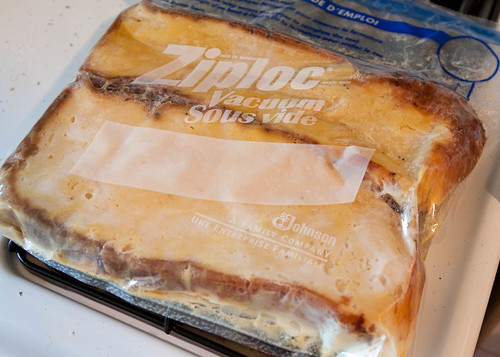I was talking about the meal we had at Per Se a year ago, and I realized I’d never posted the review here. This originally appeared on my livejournal blog, but what’s a repost among friends…
A year later, I can still taste everything on the menu.
It’s not so much a restaurant as it is a very well oiled food perfection delivery machine. Not everything was 100% perfect, mind you, but the things that weren’t were mostly of no consequence (or wrong only out of convention and not in the sense of being, say, inferior in any way), and only served to add character to the things that were. More on that.
I can’t remember the last time going out to eat gave me the giggles.
To say that the food was exquisite is missing the point – it’s just in a different class altogether. Every bite is full of both genius and playfulness. Keller’s lighthearted flavor fugue is all over the place, and it shows. For example:
Bread. They start with a choice of three kinds of bread – 9-grain, “simple” country white, or a french bread roll, with two kinds of butter. All great. But then later, they bring out something else – “this is the only bread we make here”. It’s a “Parker House roll”, little quatrains of fleur de sel crusted puffy cubes. Imagine a pretzel crossed with a croissant, and you’re mostly there. But it doesn’t stop. At the end of the explanation of the bread, the service captain tells us “we’ll revisit this later”. The dessert course has a bunch of amazing simple things on the plate; one of them is a little puddle of cream. “Remember I said we’d come back to the Parker House rolls?” The cream is ‘”Pain au Lait” Coulis’, and it’s made out of the rolls. They pulverize them in a food processor, then cook them down in a process I don’t entirely understand. But it’s outstanding.
Wine. The wine was reasonably priced. We had a bottle of Neyers 2002 Chardonnay ($50), which was great. The captain recommended individual glasses of sharper whites (which I don’t remember) for the second course, which we did and was the right decision. The bottle went with everything, one bottle lasted the meal, and it hit a perfect match with the lobster course. The wine list is a staggering book of much more expensive choices, but I think this was a fine selection.
They have over 200 kinds of plates, most of which were custom designed by Chef Thomas with Limoges. This attention to detail is in every aspect of the meal.
We each started with the Per Se cocktail – ciroc vodka with a white port, glasses washed with a fruity liquor, and garnished with two red grapes. Extremely refreshing, and smooth.
A note on the service. About halfway through the meal, we got fairly confused about who was doing what and had to have it explained. There were no fewer than 6 people involved in various parts of our meal – the waiter, the sommelier, two or three servers, and also a service captain to top it all off. They were very well coordinated, and the service was exceptionally attentive and, for lack of a better word, bright. I felt like everyone was extremely proud of their job, and rightly so.
Shortly after drinks, we ordered, and Chef Thomas’s signature amuse-bouche was presented to us – salmon tartare “ice cream cones”. A black sesame tuile filled with onion creme fraiche, topped with salmon tartare. Delightful and fresh.
** Course 1:
“Oysters and Pearls”
“Saybayon” of Pearl Tapioca with Island Creek Oysters and Iranian
Osetra Caviar
Fantastic! Thomas Keller talks a great deal about the texture of luxury in his cookbook. Strain strain strain. This is it. A sweetish custardy pudding with droplets of oceanic salty goodness.
** Course 2:
Anne:
Marinated Holland White Asparagus
White Asparagus Terrine and Garden Mache
“I feel like I’m eating Spring.”
Adam:
“Peach Melba”
Moulard Duck “Foie Gras Au Torchon”
Frog Hollow Farms Peach Jelly, Pickled White Peaches, Marinated Red Onion, and Crispy Carolina Rice
“I feel like I’m eating a big fat duck liver.”
In a sea of a meal of the best things I’ve ever tasted, this stands out. Wow. Foie gras and peaches. Perfectly smooth, fruity, creamy, and surrounded by crunchy crisp bits.
Another note on the service here. Two of the aforementioned minor imperfections in the service were on this course. First, the server spilled some of the rice crispies on the table while spooning them into the bowl. Unforgivable. Second, they served this with three slices of melba toast, and were about 45 seconds after I thought “they really should have served this with more toast” with offering more. They were going for a surprise, but missed it. Terrible.
As you can see, the service was less than outstanding. 
** Course 3:
“Pave” of South Florida Cobia “A La Plancha”
Fava Beans, Chanterelle Mushrooms, and a Preserved Meyer Lemon Emulsion
I wasn’t familiar with Cobia before, but I think this was the most well-balanced fish course I’ve ever had. The texture was great, perfect crust, a little citrus.
** Course 4:
Sweet Butter Poached Maine Lobster
“Cuit Sous Vide”
Wilted Arrowleaf Spinach and a Saffron-Vanilla Sauce
Yeah… It’s just indescribably good. I can’t even try.
** Course 5:
Pan Roasted Cavendish Farms Quail
“Puree” of Spring Onions, Apple Wood Smoked Bacon “Lardons” and Split English Peas
This seemed a little out of place to me, seasonally. But it was still amazing.
** Course 6:
Elysian Fields Farm “Carre D’Agneau Roti Entier”
Grilled Swiss Chard Ribs “en Ravigote”, Roasted Sweet Peppers, and a Nicoise Olive Sauce
I think this qualifies as a “main” course. Lamb is all good.
** Course 7:
“La Tur”
“Gelee de Pomme Verte”, Satur Famrs Red Beets and English Walnut Short Bread
Cheese course, a wedge of something creamy with tart apple gel and beets. Anne doesn’t like beets, but I found this very refreshing.
** Course 8:
Napa Valley “Verjus” Sorbet
Poached Cherries and Cream Cheese “Bavarois”
Sorbet course. My palate was refreshed!
** Course 9:
“Tentation Au Chocolat, Noisette Et Lait”
Milk Chocolate “Cremeux”, Hazelnet “Streusel” with Condensed Milk Sorbet and “Sweetened Salty Hazelnuts” and “Pain au Lait” Coulis
Formal dessert, basically a chocolate mousse with puddles of creamy things, and the Parker House bread pudding.
** “Mignardises 1″
Anne:
Creme Brulee
Anne really liked this, but I found it, to my surprise, to be too smooth. It’s the texture of luxury, but I still think that Le Cirque has it beat. It was quite delicious, but it wasn’t right for me.
Adam:
Hazelnut Panna Cotta w/ Apricots
This is Keller’s take on yogurt with fruit on the bottom. Yummy.
** “Mignardises 2″
Assortment of cookies & chocolates
Rosemary / Thyme chocolate
Here, I had an espresso, and we both had white tea. I’m quite pleased that more restaurants seem to be offering high-end teas.
The cookies were tasty and buttery, but the standout here was the filled chocolates, particularly one with a rosemary and thyme cream.
So, that’s it. Afterwards, we got a tour of the kitchen, which is like some sort of serene temple.
I had a fabulous time. Previously, I didn’t really feel up to the task of tackling any of the recipes in the French Laundry cookbook, but now I feel like I have some idea of where they’re supposed to go. This is unmistakably one of the standout meals in my appreciation for the art of cooking.



























